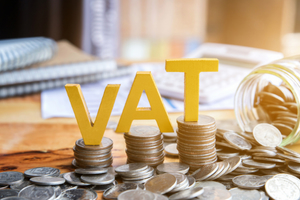TRANSFER PRICING
IN SAUDI ARABIA
Our Transfer Pricing service in Saudi Arabia is part of our tax consultancy services in Saudi Arabia.
Transfer pricing is an accounting method that refers to the price that companies within the same group charge each other for the exchange of goods and services. The transfer price typically reflects the market price of the good or service. Transfer pricing is used by multinational corporations as a method of allocating profits amongst each other for tax purposes.
HOW IS TRANSFER PRICING SET?
The Organisation for Economic Co-operation and Development (“OECD”) transfer pricing rules state that the transfer price between group entities need to reflect the market price normally charged to a third party and negotiated upon the Arm’s Length Principle which is based on an analysis of the range of real market prices of a good or service in a country; therefore, allowing a single international standard for transfer pricing and tax computation, as well as ensure governments collect their share tax while providing multinational corporations with the advantage of avoiding double taxation.
WHAT IS THE FORMULA OF TRANSFER PRICING?
The transfer pricing formula is:
Transfer Price = Outlay Cost + Opportunity Cost
Some companies calculate the minimum acceptable transfer price as equal to the variable cost, also referred to as the outlay cost or marginal cost. The marginal cost is identified as the total additional expense incurred from producing an additional unit of a good or service.
However, as per the general economic transfer price rule, most companies calculate the minimum acceptable transfer price as equal to the outlay cost plus an opportunity cost. The opportunity cost is the profit the division would make by selling the good or service in the marketplace as opposed to selling it to an internal division.
WHAT ARE THE TRANSFER PRICING METHODS?
1. COMPARABLE UNCONTROLLED PRICE (CUP)
The Comparable Uncontrolled Price method compares the price charged for a good or service transferred in a controlled transaction with the price charged for the same good or service in a comparable transaction that is uncontrolled or between independent parties.
To determine whether the price charged by Division A for a good or a service sold to its associate Division B is at arm’s length, then the following information will be considered:
- Transaction A: The price charged for a good or service in a comparable uncontrolled transaction between Division A and an unrelated Party X.
- Transaction B: The price charged for a good or service in a comparable uncontrolled transaction between Unrelated Party X and Division B.
- Transaction C: The price charged for a good or service in a comparable uncontrolled transaction between Unrelated Party A and Unrelated Party B.
Where Transaction A and Transaction B are considered internal comparable transactions as it occurred between an internal tested party and an uncontrolled party; while Transaction C is described as an external comparable transaction where it occurred between two parties that are both unrelated to the group divisions.
To be considered a CUP, controlled transactions and uncontrolled transactions should meet high standards of comparability taking into consideration the following factors: characteristics of the good and service transferred, contractual terms, economic circumstances, and pursued business strategies.
Generally, a CUP is deemed as the most direct and reliable method of applying the arm’s length principle for transfer pricing for the following reasons:
- it is based on the open market price of tested transactions between related parties.
- it also takes into consideration the agreed price between two unrelated parties to the transaction, making it a two-sided analysis.
- it provides a direct comparison between internal comparable transactions and external comparable transactions.
- it is readily available to be used for transactions that involve tangible product.
On the other side, one of the shortcomings of this method is the unavailability of an external comparable market for the good or service being supplied.
2.COST-PLUS METHOD (C+ METHOD)
In this method, the related manufacturing company is considered as the tested party in the transfer pricing analysis. The Cost-Plus method is a gross margin method as it derives its arm’s length amount from a gross profit mark-up added to the cost of goods sold incurred by the supplier of the good or service.
Instead of comparing prices to test whether a transfer price is at arm’s length, the Cost-Plus method evaluates and compares whether the gross profit mark-up earned by the associated supplier is at arm’s length to the gross profit margin earned by suppliers of comparable products in transactions to unrelated parties.
In the Cost-Plus Method, TP = COGS x (1 + cost plus mark- up), where:
- TP is the transfer price of a good or service sold by a supplier to a related party.
- COGS is the Cost of Goods Sold incurred by the supplier (including direct and indirect costs, excluding operating expenses).
- Cost plus mark-up is the gross profit mark-up or the ratio of gross profit to GOGS.
3. RESALE-MINUS METHOD
The Resale-Minus method evaluates the arm’s-length transfer price for a good or service based on the gross margin or the difference between the price at which the product is purchased and the price upon which it is sold to a third party.
TP = Resale Price – Selling Price to 3rd party
The transfer price is based on the resale price adjusted by deducting the gross margin including additional costs associated with the purchase of the good or service.
4. TRANSACTIONAL NET MARGIN (TNMM)
The Transactional Net Margin is the most used method for taxpayers recently in establishing the transfer price.
It basically compares and tests the net profit margin earned in a controlled transaction with the net profit margin earned by the related party from a transaction with a third party or the net margin earned by a third party from a comparable transaction with another third party.
Relatively similar to the Cost-Plus and Resale Price method, yet the transactional net margin requires less product comparability, and involves the comparison of the net margin rather than the gross profit margin.
5. PROFIT-SPLIT METHOD (PSM)
The profit-split method starts with identifying the incurred profit from a related-party transaction and dividing that profit amongst the associated parties based on the relative value each party contributed towards that profit in terms of the function it performed, the risks it incurred and the assets it used in the transaction. Such that, the profit split between the associated parties would be in relative to what independent parties performing a similar function would anticipate in a comparable uncontrolled transaction.
The advantages of the profit-split method:
- It is applicable in tangible and intangible property, trading activities, and financial services transaction.
- It is useful in cases where comparable transactions between unrelated parties are not available; or in cases where a transaction involves several related parties.
- It eliminates extreme result for one of the related parties, and instead, it analyses all parties involved in the controlled transaction.
The weakness of the profit-split method is relative to its actual application. For example, it may be difficult and costly to calculate the combined revenue and costs for all the related parties in the controlled transaction if the associates do not use the same accounting practices.
WHAT ARE THE RISKS OF TRANSFER PRICING
Risks related to transfer pricing are both internal and external.
- Disagreements within divisions of a group regarding the policies on pricing and transfer.
- Divisions of the group might hold and assume different types of risks.
- It could be difficult and costly to establish prices for intangible items and services.
- Tax Law compliant challenges.
- The high-cost burden due to the time and labour required in establishing a proper accounting system to execute transfer prices and support it.
TRANSFER PRICING IN SAUDI ARABIA FAQs
Transfer pricing refers to the pricing arrangements between related entities within a multinational corporation when they exchange goods, services, or intellectual property. It is crucial for businesses in Saudi Arabia, as it affects how profits are allocated across different jurisdictions for tax purposes. Proper transfer pricing ensures compliance with local regulations, minimizes the risk of double taxation, and optimizes the overall tax liability for businesses operating in multiple countries. Given Saudi Arabia’s evolving economic landscape and regulatory environment, understanding and implementing effective transfer pricing strategies is vital for companies seeking to maintain competitiveness and ensure compliance.
At Creation Business Consultants, we offer comprehensive transfer pricing services that include policy development, documentation, and compliance assistance. Our experienced team conducts detailed analyses to determine appropriate transfer pricing methods based on your business model and industry standards. We also help in preparing transfer pricing documentation required by the Saudi tax authorities, ensuring that your company meets all regulatory obligations while minimizing exposure to tax risks. Our approach combines local expertise with international best practices, providing tailored solutions that align with your strategic goals.
The Arm’s Length Principle (ALP) is a fundamental guideline in transfer pricing that requires transactions between related entities to be priced as if they were conducted between unrelated parties. This principle ensures that the transfer prices reflect market conditions and comparable transactions. In Saudi Arabia, adherence to the ALP is crucial for compliance with the Organisation for Economic Co-operation and Development (OECD) guidelines, which the Saudi tax authorities follow. By using the ALP, businesses can substantiate their transfer pricing practices, reducing the risk of disputes with tax authorities.
Choosing the right transfer pricing method involves a thorough analysis of your business operations, industry practices, and the nature of the transactions involved. Our team conducts a detailed review of your pricing strategies, examines comparable market data, and considers the regulatory requirements in Saudi Arabia. We evaluate factors such as the availability of reliable data, the level of comparability between transactions, and the functional analysis of each party involved. Based on this comprehensive assessment, we recommend the most suitable transfer pricing method that aligns with your business objectives and compliance needs.
Saudi Arabian tax authorities require businesses to maintain adequate documentation to demonstrate compliance with transfer pricing regulations. This documentation should include details about the transfer pricing policies, methodologies used, and analyses supporting the selected transfer prices. Additionally, businesses must provide information on the economic and market conditions relevant to the transactions. Creation Business Consultants helps clients prepare the necessary documentation to ensure it meets regulatory requirements and withstands potential audits or inquiries from tax authorities.
It is advisable for businesses to review their transfer pricing policies at least annually or whenever there are significant changes in business operations, market conditions, or tax regulations. Regular reviews help ensure that transfer pricing practices remain compliant and aligned with the current market environment. Changes such as mergers, acquisitions, new product lines, or shifts in the regulatory landscape can impact transfer pricing strategies. Creation Business Consultants recommends conducting periodic assessments to identify any necessary adjustments to your transfer pricing policies.
Improper transfer pricing can lead to significant risks for businesses, including tax audits, penalties, and adjustments by tax authorities. In Saudi Arabia, the consequences of non-compliance can include increased tax liabilities, fines, and reputational damage. Additionally, businesses may face disputes with tax authorities over the appropriateness of their transfer pricing methods, leading to costly litigation and resource diversion. Our team at Creation Business Consultants works diligently to mitigate these risks by ensuring that your transfer pricing practices are compliant and well-documented.
Transfer pricing plays a critical role in a company’s overall tax strategy, as it directly impacts how profits are allocated across different jurisdictions. By implementing effective transfer pricing strategies, businesses can optimize their tax liabilities, ensuring that profits are taxed at the most favorable rates. This optimization can lead to significant cost savings and improve cash flow. Creation Business Consultants assists clients in aligning their transfer pricing practices with their broader tax strategy to achieve optimal financial outcomes while maintaining compliance with local regulations.
Yes, effective transfer pricing strategies can significantly reduce a company’s overall tax liability by ensuring that profits are allocated to jurisdictions with favorable tax rates. By carefully structuring intercompany transactions and applying appropriate transfer pricing methods, businesses can achieve a tax-efficient distribution of income. However, it is essential to ensure that these strategies comply with local regulations and the Arm’s Length Principle to avoid potential legal issues. Our team at Creation Business Consultants specializes in developing transfer pricing strategies that optimize tax efficiency while maintaining compliance.
The Organisation for Economic Co-operation and Development (OECD) provides guidelines and frameworks for transfer pricing regulations, which many countries, including Saudi Arabia, adopt to ensure consistency and fairness in taxing multinational corporations. The OECD’s Transfer Pricing Guidelines emphasize the Arm’s Length Principle and outline the various transfer pricing methods that businesses can use. By adhering to these guidelines, countries can facilitate cross-border trade and prevent base erosion and profit shifting. Creation Business Consultants ensures that our clients’ transfer pricing practices align with OECD standards to promote compliance and minimize risks.
Preparing for a transfer pricing audit requires thorough documentation and a clear understanding of the transfer pricing policies in place. Businesses should ensure that they have comprehensive records demonstrating compliance with the Arm’s Length Principle and the chosen transfer pricing method. It is also essential to have a well-documented functional analysis that outlines the contributions of each party involved in the transactions. Creation Business Consultants provides support in preparing for audits by reviewing documentation, identifying potential weaknesses, and developing strategies to address any concerns raised by tax authorities.
Implementing transfer pricing policies can pose several challenges, including gathering reliable data for benchmarking, aligning intercompany pricing with business operations, and navigating complex regulatory requirements. Additionally, businesses may face difficulties in ensuring that all divisions understand and adhere to the established policies. The lack of comparability in certain transactions, especially for intangible assets, can also complicate the process. Creation Business Consultants works closely with clients to address these challenges by providing expert guidance and tailored solutions to streamline the implementation of transfer pricing policies.
Changes in tax regulations can significantly impact transfer pricing strategies, as they may alter the compliance requirements or the acceptable methods for determining transfer prices. For instance, new regulations may introduce stricter documentation requirements or change the criteria for determining arm’s length pricing. Additionally, shifts in international tax standards, such as those proposed by the OECD, may influence how transfer pricing is managed across jurisdictions. Creation Business Consultants keeps clients informed of regulatory changes and helps adapt their transfer pricing practices accordingly to maintain compliance and minimize tax risks.
When setting transfer prices, businesses should consider several factors, including the nature of the goods or services being exchanged, market conditions, the economic environment, and the specific roles and functions of each entity involved in the transaction. Other considerations include the competitive landscape, the availability of comparable data, and any legal or regulatory requirements. Creation Business Consultants assists clients in conducting a thorough analysis of these factors to ensure that transfer prices are appropriately set in line with the Arm’s Length Principle.
Currency fluctuations can impact transfer pricing by altering the relative value of transactions conducted between related entities in different currencies. Changes in exchange rates can affect the pricing of goods and services, leading to potential discrepancies in transfer pricing compliance. Businesses must consider these fluctuations when determining transfer prices to ensure they remain aligned with market conditions and the Arm’s Length Principle. Creation Business Consultants helps clients manage the impact of currency fluctuations by advising on pricing strategies that account for potential changes in exchange rates.
Conducting a transfer pricing study involves several key steps. First, we perform a comprehensive analysis of the company’s operations, including the nature of intercompany transactions, business functions, and the economic environment. Next, we identify appropriate transfer pricing methods and gather data for benchmarking against comparable transactions. Once the data is analyzed, we prepare a detailed report documenting our findings and recommendations. This report serves as the basis for establishing transfer pricing policies and ensures compliance with local regulations. Creation Business Consultants guides clients through each step of the process to ensure thoroughness and accuracy.
Saudi Arabia’s tax environment is evolving, with a focus on compliance and transparency for multinational corporations. The introduction of the Value Added Tax (VAT) and increased scrutiny on transfer pricing practices reflect the government’s commitment to aligning with international tax standards. Businesses must navigate these changes while ensuring their transfer pricing strategies comply with local regulations and international guidelines. Creation Business Consultants provides insights into the Saudi tax landscape and helps clients adapt their transfer pricing practices to meet current regulatory requirements.
Technology plays a crucial role in transfer pricing management by facilitating data analysis, documentation, and compliance tracking. Advanced software solutions can streamline the process of gathering and analyzing data for benchmarking, ensuring that businesses can make informed decisions about transfer pricing. Additionally, technology enables better collaboration among different departments and enhances the accuracy of transfer pricing documentation. Creation Business Consultants leverages technology to provide clients with efficient transfer pricing solutions that meet regulatory requirements and improve overall management.
To ensure that transfer pricing policies remain competitive, businesses should regularly review and update their pricing strategies based on market trends, regulatory changes, and evolving business operations. Engaging in periodic benchmarking studies can help identify opportunities for improvement and ensure that transfer prices reflect current market conditions. Additionally, fostering a culture of compliance and transparency within the organization is essential for maintaining competitive transfer pricing practices. Creation Business Consultants works with clients to develop dynamic transfer pricing strategies that adapt to changing market environments and business needs.














